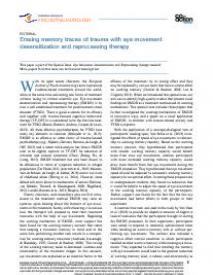Erasing memory traces of trauma with eye movement desensitization and reprocessing therapy
With its open access character, the European Journal of Psychotraumatology aims to promote evidence-based treatments around the world, while at the same time welcoming new forms of treatment without losing its critical scientific eye. Eye movement desensitization and reprocessing therapy (EMDR) is by now a well-established treatment for posttraumatic stress disorder (PTSD). There is good evidence for its efficacy and together with trauma-focused cognitive behavioral therapy (TF-CBT) it is considered to be the first-line treatment for PTSD (Bisson, Roberts, Andrew, Cooper, & Lewis, 2013).
All these effective psychotherapies for PTSD have many key elements in common (Schnyder et al., 2015). EMDR is as effective as other forms of trauma-focused psychotherapy (e.g., Nijdam, Gersons, Reitsma, de Jongh, & Olff, 2012) and a recent meta-analysis has shown EMDR even to be slightly superior to TF-CBT for reduction of intrusion and arousal symptoms (Chen, Zhang, Hu, & Liang, 2015). EMDR treatment has also been shown to be efficacious in terms of symptom reduction in refugee populations (Ter Heide, 2011; Acarturk et al., 2016; Mooren, Van de Schoot, de Jongh, & Kleber, 2016) and in survivors of childhood abuse (Ehring et al., 2014). However, some debate still exists about its mechanisms of action (Elofsson, von Schèele, Theorell, & Söndergaard, 2008; Engelhard, 2012; Landin-Romero et al., 2013; Shapiro, 2014).
In: European journal of psychotraumatology, ISSN 2000-8066 | 7 | 1 | 32545
http://dx.doi.org/10.3402/ejpt.v7.32545


